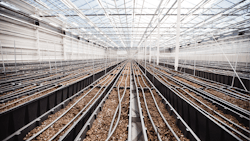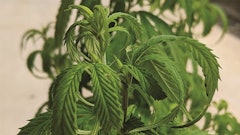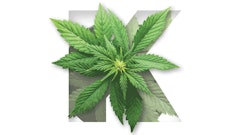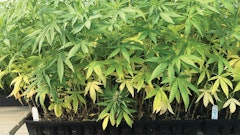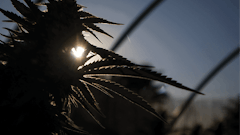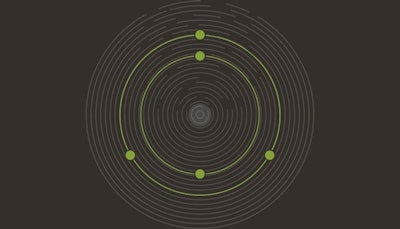
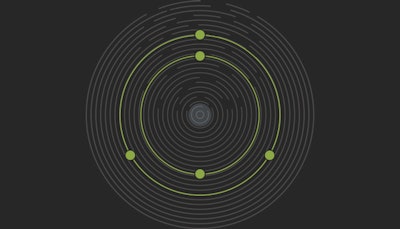
Editor's Note: This article has been updated to note the correct optimal fertilization rates of Boron for cannabis, between .875 and 1.0 ppm. We apologize for the error.
Plants, much like humans, require certain nutrients and minerals to thrive. These macro- and micronutrients help plants grow properly and complete their lifecycles, and they help growers obtain optimal yields. The micronutrient boron (B) is a necessary element for proper plant growth and development, though it is needed in small quantities. Due to the small dosage plants require, it is easy to overapply B to plants and cause damage, typically seen in the form of leaf and root necrosis or “burn” (Fig. 1). Thus, with B nutrition, there exists a “sweet spot” in which fertility is optimized but not overapplied. The B rates study conducted at North Carolina State University, sponsored by Pyxus International, an agricultural company with a portfolio that includes track-and-trace technology in the cannabis space, sought to determine the rate of B fertility that would optimize plant nutrient uptake and plant growth.
In plants, B is an immobile element that is necessary for cell elongation. Therefore, B cannot be moved (translocated) within the plant from the cell walls of older plant portions to satisfy the demand in newly developing plant portions. Boron impacts the stability and elongation of new plant growth and is especially essential for reproductive growth. Cannabis has a determinant growth habit, which means once the reproductive phase has been initiated, the plant’s terminal growing tips (the new growth at the top of the plant) will develop floral material. This floral material will not be able to properly develop if B is limited. This will directly impact flower size, quality and yield, which ultimately impacts a grower’s bottom line.

Vegetative Symptoms
Boron deficiency can easily develop in cannabis plants and can manifest in a variety of interesting symptoms. Initial symptoms include a noticeable distortion at the vegetative growing point (Fig. 2). In the early stages of B deficiency, cannabis plants will exhibit stunted growth and interveinal chlorosis (yellowing) starting at the leaf tips on the new growth. This chlorosis will appear to be a marginal “burn.” The interveinal chlorosis at the leaf tips will spread into the leaf margins (outside edges), and prolific interveinal chlorosis will develop on new plant growth (Fig. 2). As symptoms progress, new growth at the top of the plant (growing tips) will be noticeably distorted, with kinks in the new leaves (Fig. 2). Twists in new growth is also a common B deficiency symptom. As the interveinal chlorosis develops, the leaf tips become necrotic (brown) and abscise (fall off) (Fig. 3). One of the key intermediate symptoms to identify B deficiency is that the entire leaves will curl down (Fig. 3). This is different from calcium (Ca) deficiency in which only the leaf margins will curl down.
In advanced stages, the upper foliage of B-deficient plants will become thick and brittle to the touch when compared to the leaves of the middle and lower canopy. Often in late stages of B deficiency, entire leaves can become necrotic and drop. Additionally, the newer foliage will also appear discolored (overall necrotic appearance) and become severely distorted (Fig. 4). Portions of the leaf margin and the growing tips may become necrotic and abscise. Leaves will begin to curl and wrinkle (Fig. 4). The growing tip can die in severe cases of B deficiency; this will cause a proliferation of side shoots (axillary shoots). If B deficiency persists, these side shoots will also die, ultimately stopping flower development. Total plant collapse will occur in very advanced cases. The lower leaves will yellow and wilt (Fig. 5). These symptoms are caused by the death of the growing tips’ root system, curtailing the plant’s water uptake.

Flowering Symptoms
Once flower initiation begins, adequate B levels are needed for proper bud development. Plants that have acute B deficiency may not exhibit foliar symptomology. However, B-deficient plants will produce significantly smaller buds when fully matured after eight weeks of bud development when compared to plants with adequate B (Fig. 6).
In severe cases, the distorted terminal bud will quickly become necrotic and abscise from the plant. This could result in the loss of the apical cola (top cola, main bud). Plants grown under B-deficient conditions had much smaller buds when compared to plants grown with adequate B. With B being used in cell elongation, the plants grown under B-deficient conditions experienced shorter and smaller buds compared to plants grown with adequate B levels.
Findings and Conclusions
Given the results of our research, we believe that the optimal fertilization rates of B for cannabis are between .875 and 1.0 parts per million (ppm). At that range, plants were significantly larger in total plant above-ground dry weights when compared to the plants grown at 0 ppm B. The leaf tissue concentration showed an increased accumulation for all rates, with the highest rate resulting in the highest concentration of B in the leaf tissue sampled. With B also having a large impact on the flower production of cannabis, B deficiency could have a large impact on a grower’s profits. Additional research is needed to elucidate the upper ranges of B fertilization and to quantify a closer range of B toxicity levels.
The symptoms exhibited by B deficiency are like those of Ca deficiency. However, the primary difference between Ca and B deficiency is the intermediate stage. Intermediate stage B deficiency will cause the entire leaf to curl down, while intermediate stage Ca deficiency will only cause the leaf margins to curl down. Growers should be aware that the range of B deficiency and toxicity is very narrow for many crops, and the deficiency should be confirmed by a laboratory leaf tissue analysis sample before making an application to correct a problem.









